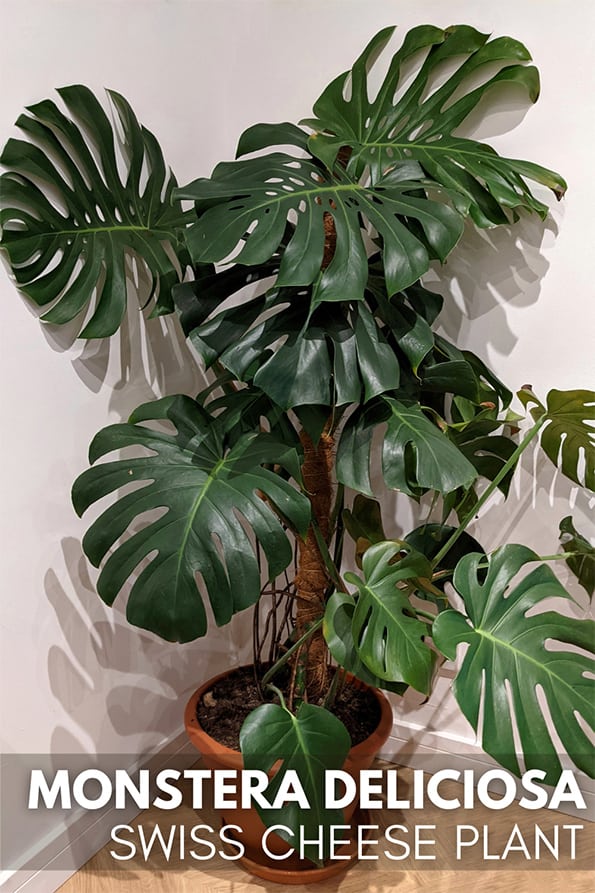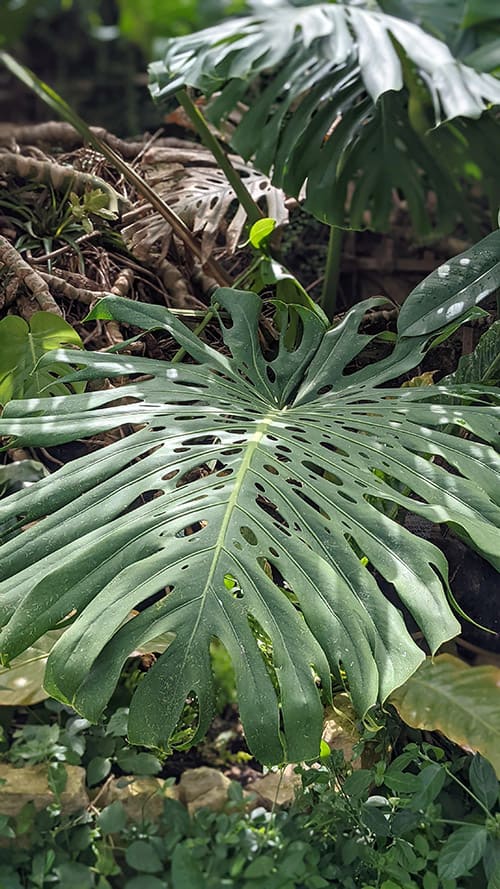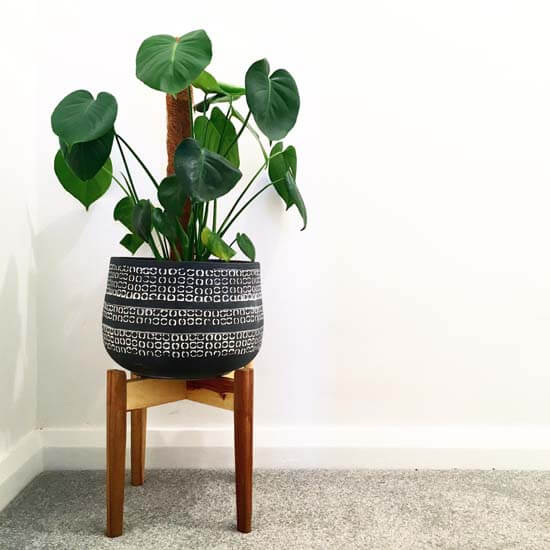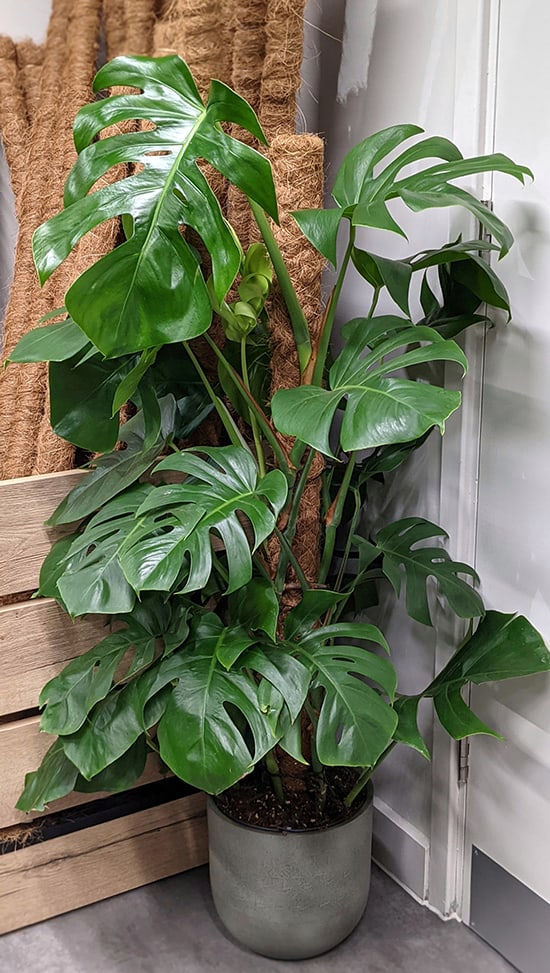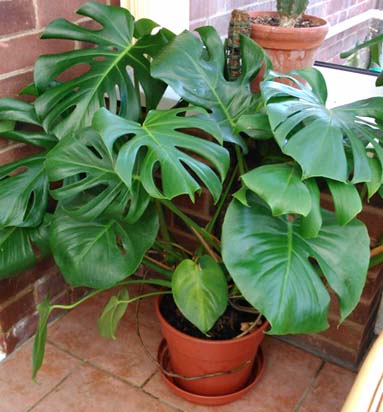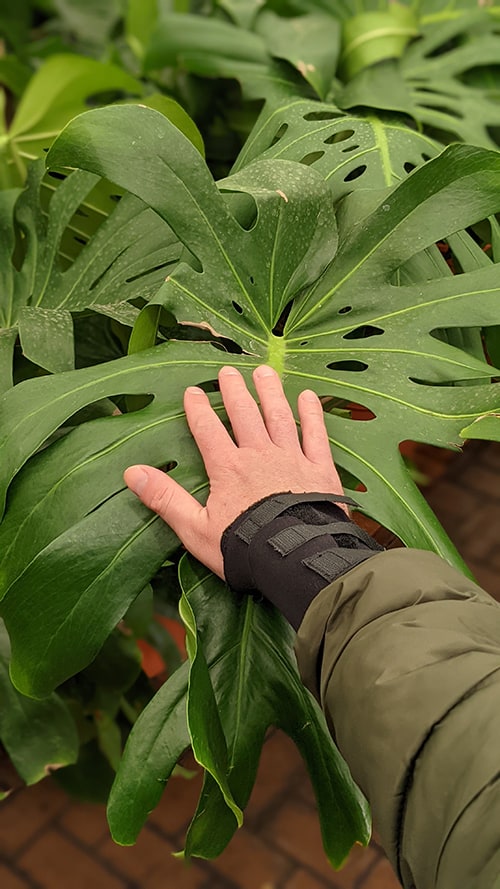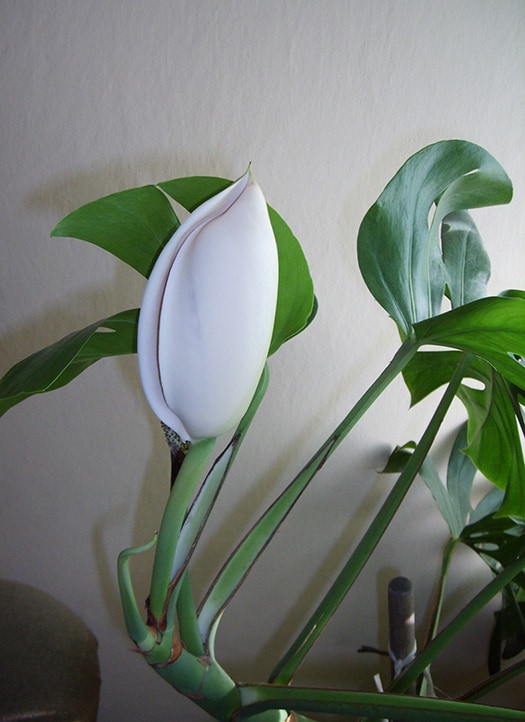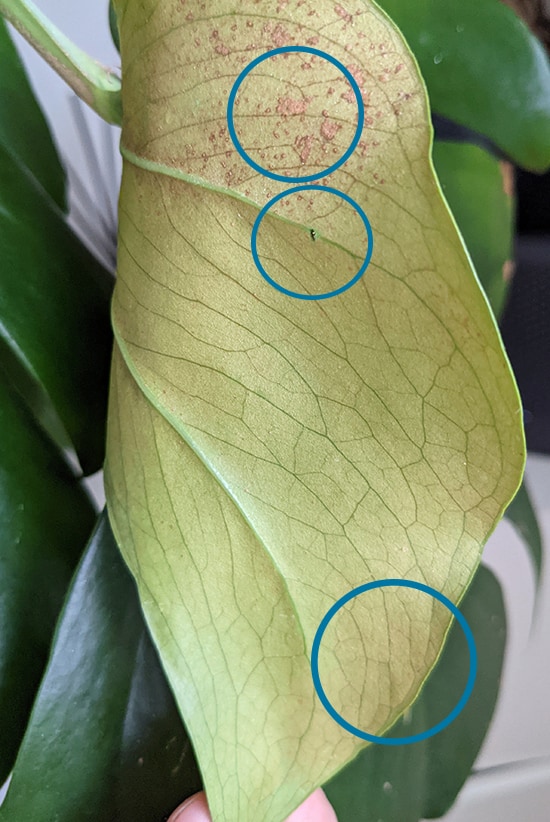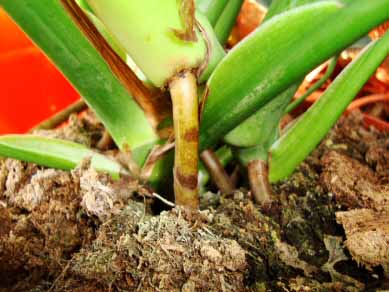Monstera deliciosa, the Hurricane or Swiss Cheese Plant are all names for an old fashioned but favorite houseplant. Look closely at the Latin name (Monstera deliciosa) which means "Delicious Monstrosity".
This is due to the edible fruit it can occasionally grow which tastes like banana and pineapple, although only a few people will encounter this because it rarely flowers indoors.
The good news, however, is that almost all owners will be growing the plant for its stunning leaves and monstrous size. All owners can experience this if they follow my plant care tips to help grow it well.
Monstera deliciosa are tropical plants that come from the rainforests of Central America. They love warm temperatures and if you can provide this and follow some basic care needs they will grow fast and large.
There's no getting around the fact, that while lovely and incredibly easy to care for, even small baby plants will eventually need a large amount of growing space. This houseplant is not for the window sill or small flat in the longer term.
The Swiss Cheese Plant will inevitably need support indoors, either from a moss stick or some stable nearby structure to which you can tie it, for example, exposed wall pipes or a sturdy floor lamp.
It originates from the tropical rainforests of southern Mexico and Central America but adapts and positively thrives in the most non-tropical places - our homes.
There's no getting around the fact, while lovely and incredibly easy to care for, it does need space.
As it ages the new leaves become Swiss Cheese like, with large cut ribbons or holes in its leaves known as fenestrations. These are a natural adaptation that has been the subject of intense study over the years. These cuts in the leaves are the reason it has the Swiss Cheese Plant common name.
For those interested, leaves with large holes like this have much better resistance to damage from downpours and hurricanes, which are common in their natural habitat.
In addition, the light levels reaching down onto the floor of a tropical rainforest is low and the light that does make it through is dappled. So the leaves with these ribbons have a larger surface area to better capture what little light filters down.
Generally, the larger the plant, the more splits and fenestrations that will appear in the leaves. They will typically need climbing support first though. If the aerial roots have nothing to secure themselves to, fenestrations will be limited or nonexistent.
Although it's been sold as a houseplant for decades, you can still only buy a handful of different cultivars. The most common variety is the all green original M. deliciosa, but you may find it being incorrectly sold as Philodendron pertusum, or a Split leaf Philodendron especially if the plant you are looking at is very small.
Alternatives
If lack of space is a problem for you then Monstera adansonii has similar looking leaves but is much smaller.
You could also have a look at the slender Mini Monstera (Rhaphidophora tetrasperma)
Monstera plants when young will not have the distinct leaf shapes that a mature specimen will develop, so it's easy to confuse it with a general Philodendron.
There are several variegated varieties which have creamy white sections on the leaves. The most common of these are the Monstera Variegata Albo and Monstera Thai Constellation. These are a little harder to care for and they grow slower.
Consequently it can be hard to get hold of these varieties, although they've very beautiful plants. They can be very expensive, so generally aren't as common as the all green variety.
If your space is limited but you really want this houseplant, look out for M. deliciosa borsigiana, which can be slightly more compact (but not by much).
You can easily tell this is a young plant because of the very simple looking heart-shaped leaves. Only mature plants will produce the popular splits (fenestrations).

Hi, I'm Tom!
If you're like me and enjoy the challenge of growing houseplants and getting them to thrive, then Ourhouseplants can help. This website shares my knowledge and years of growing plants and provides (hopefully) helpful advice on properly caring for your indoor plant friends.
Gentle sunlight is fine for the Swiss Cheese Plant, but harsh sun needs to be avoided as it will scorch and possibly yellow the leaves.
On the other side of things, dark gloomy corners need to be avoided too in order to prevent loss of the Swiss Cheese effect in the leaves and the annoying spreading effect that occurs in these conditions.
They can be pretty thirsty plants at times, so moderate levels of regular watering are required for your Swiss Cheese Plant. When you do water, make sure you aim to get all of the compost evenly moist, then wait until it has almost dried out before watering again.
You can use tap water or filtered water most plants aren't too fussy. If you have a heavy minerals, salts or added chemicals in your tap water you may need to use another type of water if you notice leaf blemishes / damage.
If you've got the room for it, want an easy going, striking and interesting green plant to add to your collection or brighten up a stale boring corner of your home, Monstera deliciosa should be on your shortlist.
You'll need to wait less time between waterings during the warmer months of the year. Additionally, if the plant has been positioned in a very warm and low humidity space, the moist soil will dry out faster.
Mature plants in smaller containers will also dry out super fast, so keep on eye on your plant and check often to make sure it's happy. Allow some drying out before you water your plant again and this will help prevent root rot from overwatering.
It will take average to high humidity levels well, but will start to suffer if things are very arid and dry for prolonged periods. Find ways that work for you to increase humidity if this is likely to be an issue in the spot you have chosen for it.
Feeding is essential if you want new, lush green growth.
Use any houseplant feed and use it at normal strength no more than once a month during periods of active growth.
Reduce the amount and frequency of feed if you find your plant is becoming too big and outgrowing its home too fast!
To prevent fertilizer burn, you should also cut back if you notice your plant has stopped growing over the winter months (this is quite common for most owners).
Visible new growth should occur whenever temperatures are regularly at 18°C / 65°F or above.
Although it will survive easily between 10°C / 50°F and 40°C / 104°F try to keep in the middle of this where possible to avoid temperature related problems.
A young plant in its first pot will need to be repotted shortly after purchase. As is usual with most houseplants, find a pot that is a bit bigger than the existing one and using new compost, pot it up into its new home.
Don't feed newly repotted plants for at least three months as the new potting soil will already have some nutrients present.
You can use a lot of different potting mixes with these plants. They're happy in everyday garden compost, but can also be grown in more open mixes or DIY blends. For example those containing orchid bark, worm castings and coconut coir or chips. It can all work well for these plants.
A small warning - think carefully before you decide to upsize the pot of an established and mature plant. Because - Bigger Pots = A MONSTER Monstera deliciosa. You've been warned!
With indirect sunlight, warmth and regular watering it's normal for a small plant to outgrow its container within a year or two. However they're not too fussed about being rootbound for a while so you don't need to repot them frequently.
You normally won't want more than one or two of these massive plants in your home for obvious reasons. But if you want to give propagation a go or you want to take cuttings for friends, you can remove the growing tips from just below a leaf node to create stem cuttings.
Once you've done this, plant the cutting (including the aerial root node) in a compost mix similar to what the parent was growing in and maintain similar conditions until established, before moving it on to its new home.
You can also root the cutting in water. If you do this, then the roots should start to form after a few weeks, and after about a month or two they should be extensive enough for you to pot up into soil.
Sometimes it's better to see things visually. So here is a great video by Crazy Plant Guy who shows you how to do it (click the image to watch).
When the plant is in active growth (this is usually, during the Spring and Summer months) it puts out quite a few new shoots and leaves, especially if properly fed and watered with good light levels.
Things usually slow down or stop completely when temperatures drop and natural light levels decrease, such as over the Winter months. However it's not uncommon for some Monstera plants to still grow the occasional leaf even in the middle of Winter.
With time comes a humongous beast. Up to 20m / 65ft high and the leaves can often reach between 25-90cm / 9-35 inches both in width and length.
Generally, the plant size will be restricted if you're not using a moss pole or some upward support. The aerial roots need to grip and grow into "something" before the plant starts to put out larger leaves.
The size and type of leaf will depend on the maturity of the plant. The older it is, the larger the leaf and the greater the number of fenestrations present.
The Swiss Cheese Plant belongs to the Araceae family, so the flowers it produces is typical in appearance to the many other plants within this family i.e. pretty unremarkable as flowers go.
Unremarkable, except for two points. Firstly if fruits are produced on your Monstera (rare indoors) you can eat them once ripe! Do some research first though, because eating the fruit before it's fully ripe isn't good for you (at all!).
But what does it taste like you ask? Well, it's supposed to be a (delicious) cross between banana and pineapple mixed with hints of various other tropical fruits.
Secondly, a large Monstera will produce a proportionally large flower which can be a fun talking point if not something overly pretty to look at.
If your plant gets to maturity it will sometimes produce a flower like this. This can eventually lead to the formation of a fruit. The ripe fruit tastes (and smells) like a delicious mix of pineapple and strawberry, which is why the plant is something known as the fruit salad plant. Photo by Pmil / Bozejmonstera
Monstera leaves and roots are toxic to people, cats and dogs. This is a result of the calcium oxalates found in the plants sap.
Fortunately the purpose of calcium oxalates is to make the plant taste unpleasant to stop people or animals from eating it rather than causing serious harm. So most of the side effects of eating Monstera are superficial at worst, such as a sore mouth, lips or tongue.
The Swiss Cheese Plant looks fantastic with shiny, polished leaves. Make sure you clean it regularly to keep this attractive look.
Leaves and stems growing into dark places.
This is often a confusing thing to see, as almost all plants will grow towards the light, not away from it. However if light levels are quite low, the young leaves and shoots on Swiss Cheese Plants will often grow towards even darker areas, which is known as negative phototropism.
Basically, they're seeking the really dark spots because out in the wild of the tropical rainforest this is where the tall trees are standing. Once reached, the shoots will clamber up them to get to the top of the open and much brighter canopy (clever no?).
In our homes, the dark spots are probably going to stay dark. So if the creeping and spreading is really bad, either fold them back into the main stem, remove these shoots completely or consider a brighter spot for the plant in general.
Dripping / Crying leaves (guttation)
After it has been well watered, you may find water droplets have formed and collected at the leaf tips. This is known scientifically as guttation and is typically harmless. If the plant is very large with many leaves it may get a bit messy.
It's caused by a lot of water being available around the roots so the cure for this is to ease up a little on the watering.
Yellowing lower leaves.
In 80% of cases this is caused by it either being too cold, too much watering or a combination of both.
Keep your Monstera plant above the recommended minimum temperature of 10°C / 50°F and reduce the amount of water you give, or wait longer before giving it some more.
In the other 20% of cases, the yellowing leaves are likely to be natural shedding of old leaves and is nothing to worry about. If none of this matches up, then I'd be looking at the possibility of Thrips (covered next).
Thrips.
Although even a small number of Thrips can devastate Monstera plants in a month or so, they're often tricky to spot compared to how much damage they cause. This is because unlike other pests like Scale Insects they're not easily seen with the human eye and they don't produce obvious by products like honeydew.
Instead Thrips strip the nutrients from inside the leaves which causes them to discolor and often start turning yellow before moving on to another leaf. Owners assume it's an environmental issue not a pest problem.
The first circle shows damage to the leaf and the plant overcompensating and creating scabby bumps. The second one shows an adult Thrip on the plant. The entire leaf is sickly but the third circle gives an example of extreme discoloration.
Thrips will cause enough damage to finish off your plant so you need to act swiftly when you notice you have them.
Yellow leaf patches.
If the yellow appears in random patches the culprit is likely harsh sunlight.
Another possibility is if the yellow appears with brown spots, it could be underwatering.
The final probable cause of yellow leaves is underfeeding. Small pots with no fertilizer, while helpful in restricting growth, will eventually cause the Swiss Cheese Plant to suffer. If you don't want to (or can't) repot your plant, then feed sparingly every month and you should start to see an improvement.
Aerial roots.
In general the only beautiful roots you find on houseplants that you actually want to see, are those of the Moth Orchid. So having brown creeping roots appearing higher up on Monstera stems might not be your cup of tea.
Aerial roots will help support your plant to climb. But if there is nothing for them to grab onto, then they can grow to very long lengths.
In the wild they function to help anchor the long weak stem to nearby structures such as trees and provide additional access to water and nutrients. Indoors, under your careful care and attention, this isn't such a big issue so you have three choices:
Of the options listed, three is the best for the plant's health and appearance. However, the Swiss Cheese Plant is robust, and removing the aerial roots is unlikely to do long-term harm.
My Monstera is too big!
Yes it does that I'm afraid! Pruning doesn't really give a neat and tidy look, so you can either just chop the plant to the height you want it to be (replacement growth should form in time).
Or you can restrict its growth by only feeding it sparingly and keeping it in a small pot. Keep the roots restricted and you will limit the amount of green leaf growth.
My Monstera is too small!
Plants that are not growing and considered small need the opposite treatment to what I've said in the previous problem. They need a larger container, more regular feeding and probably a moss pole to help it climb. Don't forget to follow up recommendations for light, water and temperature as well.
No holes in my Swiss Cheese Plant.
The leaves of young plants or on very new stems are usually uncut with little or no perforation. The cut effect will come with age.
If you have a Swiss Cheese Plant that is a few years old that still doesn't have fenestrations then the most common cause is a lack of climbing support such as a moss totem, too little light or possibly underfeeding.
Brown leaf edges / Papery tips.
Brown tips can be a sign of overwatering, if this is indicated, you'll get yellow leaves too.
Brown tips with a yellow margin nearby is typically fertilizer burn (too many salts and nutrients have built up in the potting mix, flush the potting mix and only feed sporadically going forward).
If the brown effect appears on its own with no yellowing, then it's almost certainly caused by very low humidity, cut the dead brown bits off and increase humidity to prevent further damage. Check your choice of placement too, for example if it's next to a radiator or air conditioner, think about moving the plant while they're in use.
